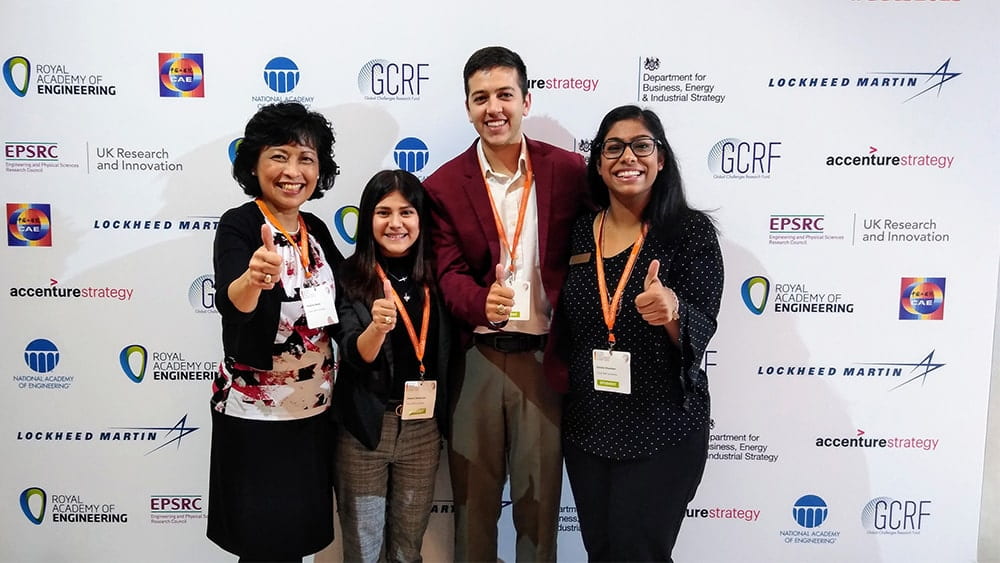
The Global Grand Challenges Summit (GGCS) is a collaborative lab and conference event, bringing together engineering minds from all over the world. The summit, which took place on Sept. 16-18 in London, was hosted by the U.K. Royal Academy of Engineering, U.S. National Academy of Engineering (NAE) and Chinese Academy of Engineering.
Engineering deans from participating institutions were asked to nominate student delegates to represent their institution at the summit. Jainita Chauhan, Brian Welsh, and Jessica Zamarripa attended the event, representing AggiE_Challenge, headed by Magda Lagoudas, executive director of the industry and nonprofit partnerships program and the Grand Challenge Scholars program (GCSP), headed by Dr. Kristi Shryock, director of GCSP. Both programs, while different, introduce students to multidisciplinary research aimed at solving engineering grand challenges.
“Being able to participate in the Global Grand Challenge Summit as a first-generation Mexican American student was a wonderful, inspirational and humbling experience,” said Zamarripa, a senior electrical engineering student. “The program gave me a better insight on real-world problems that I was able to relate back to the undergraduate research topics I currently work on.”
The summit theme was "Engineering in an Unpredictable World," with two subthemes: “Will AI and Other Transformational Technologies Change Humanity for the Better?” and “Can We Sustain 10 Billion People?” It brought together over 900 of the next generation's engineers, researchers, innovators, entrepreneurs and policymakers. Pauline Wade, assistant program director of the GCSP, accompanied the students and served as a mentor.
“Working as a mentor reinforced the importance of working with other disciplines in proposing a sustainable solution,” Wade said. “The top teams clearly explained the engineering innovation, but also quantified global impact, revenue sources, financial sustainability, distribution methods and market penetration.”
The first five days of the summit were structured as a collaboration lab where students from universities in each of the three academies were able to network, attend personal development sessions and work in multinational teams in a hackathon event to propose a solution addressing at least one of the NAE's Engineering Grand Challenges or one of the UNESCO Sustainable Development Goals.
“I was blown away with the work and communications that occurred in my team - a team of myself, another U.S. student, a student from Spain studying at Imperial College in London, and two Chinese students,” said Chauhan, a sophomore industrial and systems engineering student. “We were tasked with developing a full-fledged business proposal to solve a global grand challenge and address the United Nations’ sustainable development goals. All in the short time of 24 hours, we produced a problem statement, solution, market plan, financial analysis and many more aspects of the solution.”

Prior to the summit, Chauhan and Welsh were each conducting research centered on the NAE grand challenge “Restore and Improve Urban Infrastructure,” just with very different approaches.
Chauhan joined an AggiE Challenge team called Disaster City Digital Twin focusing on disaster relief.
“My team developed online software that solves the communication and coordination gap between humanitarian actor networks at the time of a disaster,” she said. “Thus, allowing them to provide relief to disaster victims in a more efficient and systematic manner.”
Welsh focused on determining the strength of concrete in buildings after they have been exposed to repeated cyclic loading, like earthquakes.
“By being able to quickly and effectively determine the residual strength of concrete buildings after being damaged, disaster relief teams could safely clear buildings for resumed usage much more quickly, allowing people to return to their daily lives sooner,” said Welsh, a senior civil and environmental engineering student. “The team I work on has been developing a machine learning-based algorithm to accomplish this, and we are currently comparing the results to existing concrete strength simulations.”
Welsh aspires to one day work for a company “revolutionizing urban development to create buildings and cities that function more cohesively, serve the public more efficiently and reduce environmental impact.”
“After attending this conference, I've had my eyes opened to so many other pressing problems our world faces, and ways I can contribute to solving them, that I'm having second thoughts about the classic ‘safe’ job path that I thought I wanted,” he said. “I'm not planning on completely shifting my career path, but I believe my priorities in selecting a job have changed.”
“Whether we like it or not, the world is changing and as engineers,” Welsh said. “We have a responsibility to ensure we are keeping on top of the problems that arise, and are creating a sustainable future for everyone. Everyone is capable of playing a role in shaping this change, whether it be large or small, and if you feel you want to be involved in some way, take initiative and find a way.”